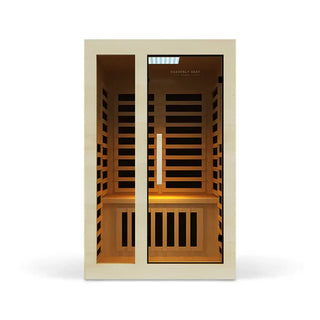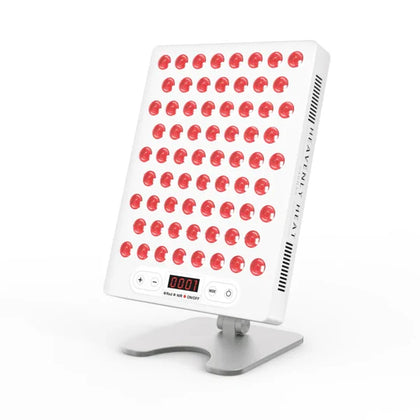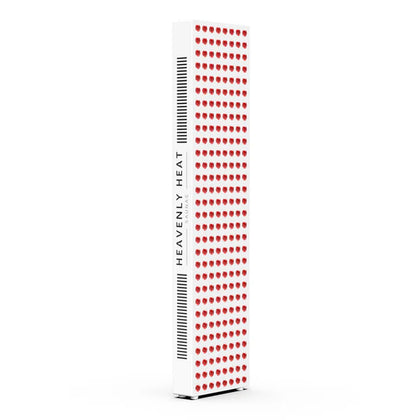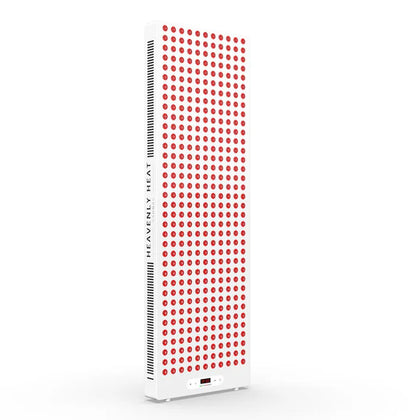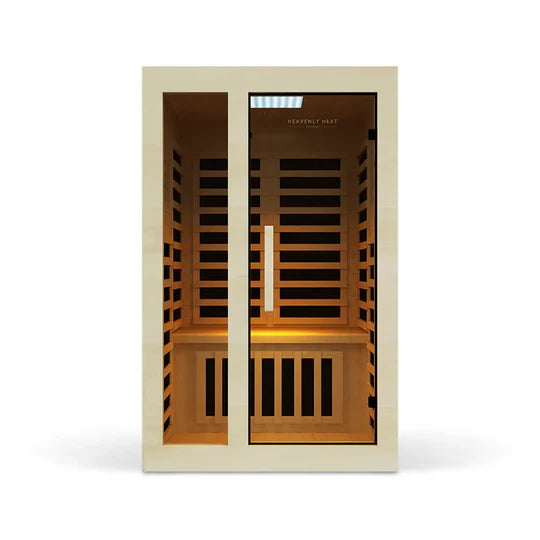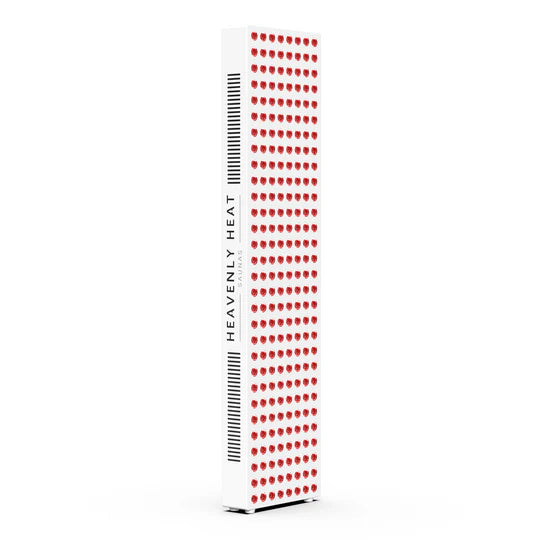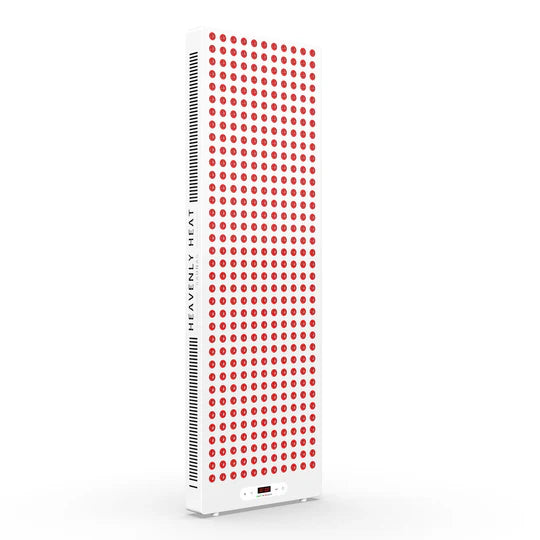Can You Do Red Light Therapy at Home?

Table of contents
Red light therapy has become a popular trend for improving health at home. People are turning to this non-invasive treatment for skin health, muscle recovery, pain relief, and overall wellness.
With its growing accessibility and affordability, it's easier than ever to set up a red light therapy routine at home. But is it as effective as professional treatments? Keep reading to find out!

Key Takeaways
-
Red light therapy at home is cost-effective and convenient, offering a practical alternative to professional treatments.
-
It can improve skin health, aid muscle recovery, and relieve pain by boosting circulation and reducing inflammation.
-
At-home devices vary in size and type, with options like handheld devices, lamps, and panels to suit different needs.
-
Ensure proper setup, including device placement and session time, for the best results at home.
-
Consistency is key: regular use, typically 3-5 times a week, yields the most noticeable benefits.
Why Red Light Therapy Gained Popularity at Home?
Convenience and Accessibility
- Using red light therapy at home saves time and effort: Red light therapy is now easy to use at home with compact devices. People can treat themselves anytime, avoiding the need to visit a clinic.
- New technology makes home devices cheaper and better: Thanks to improved technology, home devices are now more affordable and work better. Over time, they have also become safer and more efficient.
- Choosing the right device matters for good results: Not every at-home device works well. Some low-quality options may not give results, so picking a good device and using it regularly is important.
Cost-Effective
- Home devices save money in the long run : Red light therapy has become more accessible thanks to compact, affordable devices. You no longer need expensive clinic visits, just a one-time purchase for daily use.
- No more waiting for clinic appointments: Skip the hassle of booking sessions. With at-home devices, you get treatments anytime, fitting perfectly into your schedule.
- Cheaper doesn’t always mean better: Some budget devices lack the right power or quality. Picking a reliable one ensures real results instead of wasted time and money.
- Modern devices work better and safer: Early at-home models were weak, but today’s versions are stronger, safer, and just as good as professional treatments—without the high cost.
- Experts agree: Consistency is key: Dermatologist Laurence Newman confirms: "Regular home use leads to better skin results over time." No need for repeat clinic fees, just steady progress at home.
Improved Skin Health
- Red light helps skin look younger by building more collagen: Red light therapy boosts collagen production, which makes the skin firmer and reduces wrinkles. This helps your skin look smoother and younger over time.
- It clears up acne marks and gives the skin a fresh start: The therapy speeds up how fast your skin replaces old cells. This helps fade acne scars, blemishes, and gives your face a cleaner, healthier appearance.
- Better blood flow means less swelling and fewer marks: Red light goes deep into your skin, improving blood circulation and calming down inflammation . Over time, this helps reduce stretch marks, scars, and redness.
- Using the right skincare with red light makes it work even better: If you use a water-based serum before your session, the light can work deeper. Then applying moisturizers or active serums afterward helps your skin soak in the good stuff faster, thanks to better blood flow.
- Red light is a smart option for people who often get acne: Since acne affects 80% of people between ages 11 and 30, red light therapy is a simple and helpful way to support clearer skin at home without harsh treatments.

Muscle Recovery and Pain Relief
- Red light helps muscles heal faster by improving blood flow: Red light therapy boosts circulation, which helps carry nutrients and oxygen to sore muscles, speeding up the healing process after workouts .
- It reduces inflammation so your body feels less sore: By lowering inflammation, red light therapy helps ease the tightness and discomfort that come after intense exercise.
- Using it regularly gives better results over time: Doing 15-minute sessions, 3 to 5 times a week for a few months, can lead to noticeable relief and faster recovery.
- It helps with long-term pain like arthritis and fibromyalgia: Red light therapy supports tissue repair and reduces chronic pain, making life easier for people who suffer from joint or muscle issues.
- It’s a natural way to recover without pills or side effects: Since it’s drug-free and non-invasive, red light therapy helps you stay active and feel better without needing medication.
Non-Invasive and Safe
- Red light therapy works without cutting or poking your skin: What makes red light therapy attractive is that it doesn’t involve needles, surgery, or any painful methods. It heals your body gently without causing damage.
- It’s gentle enough for even the most sensitive skin: This therapy is safe for almost all skin types, including people with sensitive skin. It doesn’t use harmful UV rays or strong chemicals, so it won’t irritate your skin.
- You don’t need to rest or recover after using it: Unlike many treatments that need recovery time, red light therapy lets you go on with your day right after using it. There’s no downtime or worry.
- It’s safe when you follow the rules: Using red light therapy the right way is generally safe. But if you use it too much or with too much intensity, it can cause burns, skin damage, or hurt your eyes.
- It might help with blood sugar, but more proof is needed: Some research shows red light therapy could help control blood sugar in healthy people. But for people with health problems like diabetes or heart disease, more studies are needed to know if it’s truly safe and effective.
Scientific Backing and Increasing Awareness
- Red light therapy works because science says so: Studies have proven that red light therapy helps with things like better skin, less pain, and faster muscle recovery. This strong scientific backing is one of the biggest reasons it's gaining popularity.
- More doctors are starting to recommend it: As more research confirms the benefits , even medical professionals are suggesting red light therapy for things like skin care and long-term pain problems. This builds trust and boosts its reputation.
- Not many people actually know about it: Even though there’s solid proof that it works, most people still haven’t heard much about red light therapy. A 2023 survey showed only 22% of adults knew about its health benefits, which shows that public awareness is still low.
- Easy-to-use home devices are making it more popular: Because devices are now easier to find and use at home, more people are giving red light therapy a try. As word spreads and awareness grows, using it for personal wellness is becoming more common.
Versatility for Various Health Issues
- Red light therapy helps reduce pain without needing pills: Red light therapy is a great option for managing chronic pain and inflammation, especially for issues like back pain or joint stiffness, giving relief without medication.
- It supports healing in both small and serious injuries: Whether it’s a recent injury or something that’s been bothering you for a while, red light therapy can help by reducing swelling and repairing damaged tissues.
- It helps muscles recover faster after workouts: People who exercise regularly or play sports use red light therapy to recover quicker, feel less sore, and get back to training sooner.
- It improves blood flow, which helps your body heal faster: Better circulation means your body gets more oxygen and nutrients where it needs them, which speeds up healing and reduces swelling in injured areas.

Different Types of Red Light Therapy Devices for Home Use
Red Light Therapy Lamps
- Red light therapy lamps come in different shapes and sizes: Red light therapy lamps are available as handheld devices, desktop models, and larger setups like panels or therapy beds. This gives you options based on whether you want something small and portable or something for full-body treatment.
- These lamps use light that goes deep into your skin to heal: The red and near-infrared light from these lamps penetrates your skin and tissues, helping to reduce pain, ease inflammation, and promote faster healing.
- Bigger lamps help treat more areas at once: Large models like therapy beds or wall panels are designed to cover multiple parts of the body at the same time, making them a good choice if you want quicker sessions or need full-body relief.
- Picking the right lamp depends on what you need at home: Before buying, think about how big the lamp is, how strong the light is, how easy it is to move, and what type of light it gives off (600–650nm for red light and 800–880nm for near-infrared). These details affect how well it works for your needs.
- Using these lamps at home is safe if the device is trusted: Red light therapy lamps are generally safe to use at home. To stay on the safe side, look for FDA-cleared products that meet tested health and safety standards.
Handheld Red Light Therapy Devices
- These small devices are easy to carry and perfect for treating one spot at a time: Handheld red light therapy devices are compact and portable, allowing you to target specific areas for therapy. This makes them great for focused treatment, whether you're using them at home, at work, or while traveling.
- The light goes deep into your skin to help your body heal from the inside: These devices emit light that penetrates the skin, stimulating your cells. This action helps the body heal itself, reduce swelling, and ease pain naturally.
- They help muscles recover faster by improving blood flow: One of the key benefits of handheld devices is their ability to boost circulation. More blood flow means faster healing, less soreness, and better muscle recovery after workouts or injuries.
- Best for treating wrinkles, joint pain, or small body parts: Handheld red light devices are ideal for smaller treatment areas like the face or joints. They're a great option for reducing fine lines or easing joint stiffness in specific spots.
- They take more time to use on large areas compared to bigger devices: While effective, handheld devices need more time if you're trying to treat a big area like your back or legs. Panel devices are faster because they cover more space at once.
- Even though they’re small, they still give real results for sore muscles: Handheld devices may not go as deep or wide as bigger machines, but they still work well, especially if you're using them regularly on sore muscles or small areas that need healing.
Red Light Therapy Panels
- Red light panels cover more of your body in one go: Red light therapy panels are big enough to treat large parts of your body at once, making them more effective than small handheld devices when you want full-body results.
- The light from these panels goes deep to help your skin and muscles: These panels use a mix of red and near-infrared light that goes deep into your skin. This helps boost healing, reduces pain, and supports healthier-looking skin by promoting collagen.
- High power means you see faster results: Because of their strong power output, red light panels work more quickly and effectively, especially useful if you want to see improvements in less time.
- You can set them up easily at home without any help: Most red light therapy panels are made for home use, with simple setups that don’t require professional installation or tools.
- Using the panel daily is simple and stress-free: These devices are designed for everyday people. They come with clear instructions, easy buttons, and adjustable settings that make using them quick and comfortable.
- Look for good power and the right kind of light when buying: When choosing a panel, make sure it has enough power, adjustable settings, and a good mix of red and near-infrared light so it matches what your body needs.
Red Light Therapy Masks
- Red light therapy masks help make your face look younger: Red light and near-infrared light from these masks boost collagen, which helps smooth wrinkles, firm the skin, and improve your overall facial appearance.
- These masks are good for acne, fine lines, and dull skin: If you're dealing with breakouts, signs of aging, or a tired-looking face, red light masks can help refresh and clear up your skin over time.
- People with sensitive skin can use these masks safely: Red light masks are gentle enough for conditions like rosacea or eczema. They reduce redness and calm the skin without causing irritation.
- You can use the mask without holding it, which saves time: Because these masks are hands-free, you can wear them while doing other things, making it easy to use regularly without changing your routine.
Red Light Therapy Beds
- Red light therapy beds cover your whole body in healing light: Red light therapy beds are big, full-body devices that shine red and near-infrared light over your entire body. This gives complete coverage, unlike smaller devices that target only one area at a time.
- You may start seeing changes in your skin and pain within 1–2 weeks: Most people begin noticing smoother skin and less inflammation after just a few sessions. These early results can happen in the first one to two weeks of regular use.
- Using the bed for several weeks helps with deeper pain and recovery: To get more serious results, like relief from long-term pain or better muscle recovery, you usually need to keep using the bed for four to twelve weeks.
- Red light therapy beds are safe, but you should still use them wisely: These beds are generally safe for most people, but it's important to follow safety instructions. Your age and any health issues you have should be considered before using them.
- This is the best option if you want full-body red light therapy at home: If you’re looking for a device that treats your entire body at once, a red light therapy bed is the most complete and convenient choice for home use.
Red Light Therapy Wraps and Pads
- These wraps are soft and bend easily to fit your body: Red light therapy wraps and pads are flexible devices that can wrap around your joints, muscles, or back. This makes them perfect for home use, especially when you want to focus on one painful area.
- They shine healing light deep into your skin: The LED light from these wraps goes beneath the surface of your skin. This helps repair tissue, ease pain, and even improve how your skin looks and feels.
- Great choice if you have sore muscles or stiff joints: People dealing with muscle soreness or joint pain can benefit a lot from these wraps. They help bring relief where it's needed most without needing medication.
- Works better than using heat or ice alone: While heat or ice can offer temporary relief, red light therapy wraps do more. They help your cells heal faster and reduce swelling, so your body recovers quicker and feels better longer.
How to Set Up Red Light Therapy at Home?
Choose the Right Device
- Choosing the wrong device can waste your time: There are many red light therapy devices available, handheld tools, light panels, and wearables. Picking the wrong one for your needs means you might not get the results you expect.
- Your treatment area should decide your device: If you’re treating a small area like your face, a compact device is enough. But for larger areas like your back or legs, you’ll need a bigger panel to cover it properly.
- Short sessions work only for small areas: Smaller body parts don’t need long therapy sessions. But if you’re using the device on a larger area, make sure you give it enough time for the light to work effectively.
- Sitting too far or using the wrong light won’t help: Many people make the mistake of sitting too far away, using the wrong wavelength, or not wearing eye protection. These simple errors can reduce how well the therapy works.
- Following simple steps helps you get faster results: When you use the right device the right way, close enough, with proper timing and protection, you’ll see better and quicker results from your therapy at home.
Select a Suitable Location
Choose a quiet, well-ventilated spot with enough space for the device. A bedroom or living room is ideal. If you have limited space, a smaller handheld device can be used on a tabletop.
Ensure Proper Power Supply
Red light therapy devices typically require a regular power outlet. Ensure the area has a stable power supply and avoid overloading the circuit with other devices. It’s wise to use a surge protector.
Position the Device Correctly
Position the device about 6 to 12 inches from your skin. For larger devices like panels, place them horizontally or vertically to ensure even coverage.
Set a Comfortable Treatment Time
Sessions typically last between 10 to 20 minutes per treatment area. Start with shorter sessions and gradually increase the time. Be mindful of how your skin reacts during the sessions.
Are At-Home Red Light Therapy Devices as Effective as Professional Treatments?
- At-home devices can give good results if used regularly: At-home red light therapy devices can still improve your skin, ease pain, and help with muscle recovery, but only if you use them consistently over time.
- Professional machines work faster because they’re stronger: Treatments done at clinics often show results more quickly because the machines are more powerful and cover bigger areas in less time.
- Home devices take longer and need more patience: Since home-use devices are less powerful, you might need more sessions and more time to see the same kind of changes you’d get from a clinic.
- The final results can still be similar if you stay consistent: Even though it takes longer, with regular use, at-home devices can lead to noticeable improvements just like the ones from professional treatments.
How to Clean and Maintain Your Red Light Therapy Device?
Turn Off and Unplug the Device
Always turn off and unplug the device before cleaning to avoid any electrical hazards.
Use a Soft Cloth for Cleaning
Clean the device with a soft, microfiber cloth to avoid scratches and lint buildup.
Clean the Lights with Caution
Wipe the device monthly with a damp cloth, avoiding harsh chemicals. Be cautious with moisture near electrical components.
Check for Dust or Debris
Inspect for dust and debris every couple of weeks and remove it with a dry cloth or brush.
Inspect Wires and Cords
Check wires for wear, fraying, or exposed parts. Replace damaged cords to prevent safety hazards.
Store Properly When Not in Use
Store the device in a cool, dry place, away from direct sunlight and moisture.
What You Need to Know Before Trying Red Light Therapy at Home?
Before trying red light therapy at home, it's important to understand the potential risks. Overuse can lead to skin irritation or eye damage, so be cautious.
If you take medications that increase skin or eye sensitivity or have a history of skin cancer or eye problems, it’s best to consult with a doctor before starting treatment.
Start with shorter sessions and gradually increase the time as needed. Consistency is key, so aim for 3 to 5 sessions per week to see the best results.
FAQs
What Should You Expect After Your First Red Light Therapy Session at Home?
Your skin might feel a little warmer or tingly after the first session. Any redness should be mild and temporary.
How Soon Will You See Results from Red Light Therapy at Home?
Visible improvements can take around 2 to 3 weeks with consistent use, but results may vary.
Can You Combine Red Light Therapy with Other Treatments at Home?
Yes, combining it with facial masks or topical treatments can enhance results, as it boosts circulation and absorption.
What is the Ideal Distance for Using a Red Light Therapy Device at Home?
Typically, maintain a distance of 6 to 12 inches from the device for the most effective results.
How Often Should You Do Red Light Therapy at Home for Maximum Benefits?
3 to 5 sessions per week are ideal for noticeable results.
Is It Safe to Use Red Light Therapy at Home Every Day?
While generally safe, it’s important to avoid overuse. Daily use might lead to irritation, especially with high-intensity devices.




